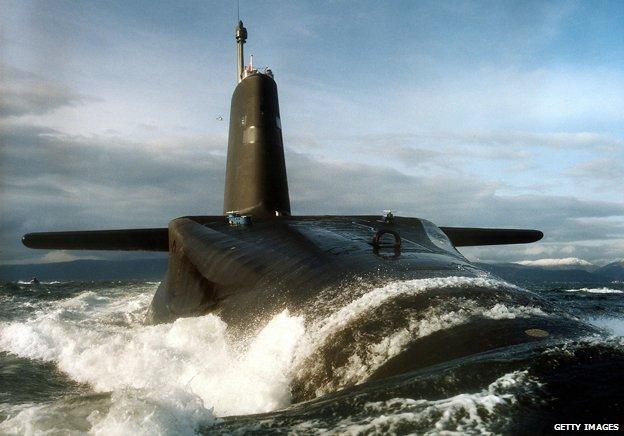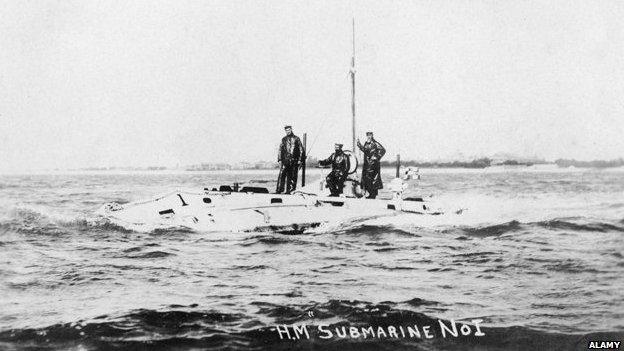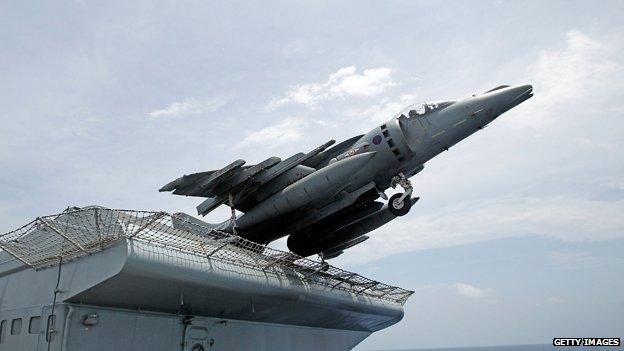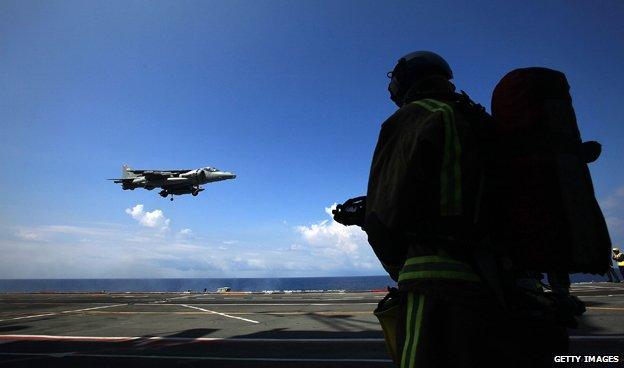The menace under the sea
- Published

HMS Vanguard
Sea battles were transformed in the 20th Century by the advent of two technological advances - the submarine and naval air power.
The dawn of the 20th Century saw a technological revolution in many ways like the one we are living through now.
Like today, it started with eccentrics experimenting with new ideas, and like today those ideas would transform the world. But unlike today's revolution, driven by computers, communication and consumer products, in the early 20th Century the technology which really caught the public imagination was naval. And within 50 years two breakthroughs - enabling men to travel both below the water and above it - completely transformed how war was fought.
Submarines came first. The US and French navies were the first to get submarines in large numbers. The Royal Navy came slightly late to the game - and only bought its first submarines to understand how they worked and how to defend against them. At best, the Navy hoped they might be able to save money by having submarines instead of expensive minefields and shore defences.
But it rapidly became clear that these were incredibly offensive weapons. As Admiral Lord West, a former head of the Royal Navy, says: "The way to sink a ship is to knock a hole in its bottom and suddenly here we had a way of achieving that."
The full potential of the submarine was not realised until World War One, according to George Malcolmson, archivist at the Royal Navy Submarine Museum. But he says Reginald Bacon, in charge of testing the new weapons, did report very quickly to the Admiralty that "the submarines changed the way that the surface fleet would operate".
This was key. Submarines, torpedoes and mines forced the Royal Navy to find new ways to fight at sea. Mounting a blockade just outside enemy ports was no longer safe, and fear of the torpedo had a major impact on important battles during WW1. At Jutland, for example, the greatest naval battle of the war, Admiral Jellicoe turned the Royal Navy's grand fleet away at a key moment because of the fear of torpedoes.

The Holland 1 was the first submarine commissioned by the Royal Navy
Submarines changed the rules of war, too. Until then, convention dictated that before sinking an unarmed vessel, a warship had first to warn and then evacuate a ship's crew. But submarines were too small to accommodate another crew, while surfacing would make them vulnerable to being shot at and sunk.
Instead, the German navy eventually moved to a policy of "unrestricted" submarine warfare - sinking merchant shipping on sight and without warning. Initially this was incredibly controversial. Submariners were viewed as pirates - and Royal Navy submarines still fly the "jolly roger" today as a way of nodding to that part of their tradition. But after WW1, when Britain tried to get submarines banned, there was little support. International opinion had adjusted to this new horror.

Technology to fight above the waves has had an equally disruptive effect on war at sea. The Royal Navy was quick to experiment with aircraft and during WW1 invented the world's first aircraft carriers.
But it was not until World War Two that naval air power came into its own. First the German air force, the Luftwaffe, revealed the destructive potential of aircraft on ships. Then the Japanese demonstrated the enormous potential of aircraft carriers for power projection.
The Battle of the Coral Sea, just north of Australia in May 1942, was the first time that a battle was fought at sea when the opposing surface ships never saw each other. Between 1941 and 1945 the war in the Pacific was all about naval air power.
The place of naval air power had been established - but there was one further development under the waves which would have an immense impact on how war was fought. The development of nuclear propulsion produced what Malcolmson calls the "first true submarines". It meant they could travel underwater for long periods without needing to recharge batteries, surface, and give away their position.

Rear-Admiral Mark Beverstock, chief of the Strategic Systems Executive, who is responsible for the Royal Navy's Trident submarines, says that "the advent of nuclear propulsion into the submarine was an absolute game changer for strategic deployability". The Royal Navy - and other navies around the world - soon used their nuclear-powered submarines to carry their strategic nuclear weapons, making them much less vulnerable to enemy attack. It made them, effectively, the capital ships of the Royal Navy - the ships around which the rest of the navy was built.
Today, the world's more powerful navies all have both submarines and aircraft carriers in them. For everyone else, submarines and aircraft continue to have an effect on the behaviour of the surface fleet, just as Reginald Bacon observed in 1903.
As we listen to the history of WW1 and WW2, it is worth remembering how completely war at sea has changed since then.
The 15-part series Britain at Sea is presented by Admiral Lord West. It is broadcast daily every weekday at 13:45 BST, on BBC Radio 4
Subscribe to the BBC News Magazine's email newsletter to get articles sent to your inbox.